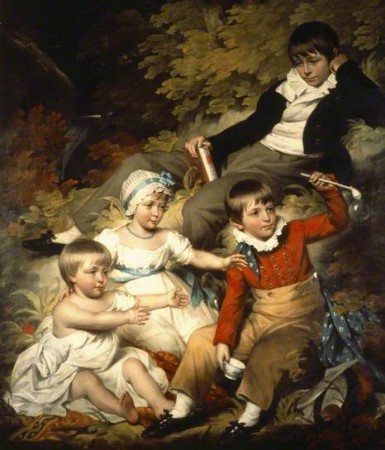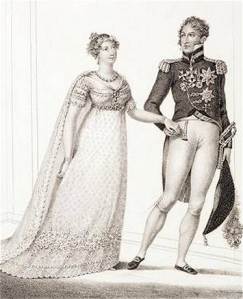
Credit: The National Trust
On Monday I blogged about this portrait of Richard Croft’s children—where Herbert, aged ten, is lying in the pose of Melancholy, in the background in partial shadow, due to his having died.
The children’s father, the 6th Baronet Richard Croft, has his own tragic story.
Croft was a doctor from an aristocratic family, and in 1817 he became the personal physician overseeing the pregnancy of Princess Charlotte, second in line, after her father, to the British throne. At the time, doctors could do little to hasten the birth of a child during a difficult labor; labor-hastening drugs were not available, and, in this pre-anesthesia, pre-antibiotic world, Caesarean section almost always led to the death of the mother, from shock or sepsis. Obstetrical forceps were known, but Croft was part of a group of influential obstetricians who thought they should be used only as a last resort.

Princess Charlotte and Prince Leopold on their wedding day
The princess went into labor two weeks after her expected due date. After fifty hours of difficult labor, she finally delivered a nine pound baby boy, but he was stillborn. The princess lost more blood, began vomiting, and died five hours after delivery, probably from hemorrhagic shock. She was 21.
The nation was grief stricken. Had the princess survived, she would have become Queen of England upon the death of her unpopular father, George IV, and her grandfather, George III, whom the public perceived as mad.
Although a report issued two weeks later held Dr. Croft blameless for the beloved princess’s death, it’s likely that had he used forceps both the baby and the mother might have been saved.
Despondent about the deaths, Croft shot himself three months later.
After Charlotte’s death, there was a scramble to determine who would succeed the Prince Regent, who was 59 and had no more legitimate offspring. The brothers of the prince regent (Charlotte’s father), were ordered to dump their mistresses and find suitable wives. One of Charlotte’s uncles, Edward, the Duke of Kent, was hastily married off to the sister of Leopold (Charlotte’s widower). The line of succession would pass to Edward, and then to their child, who was born in 1819. She assumed the British throne in 1837, as Queen Victoria.
Sources: Pitkin, Whom the Gods Love Die Young: A Modern Medical Perspective on Illnesses that Caused the Early Death of Famous People 48-51
http://www.newyorker.com/archive/2006/10/09/061009fa_fact?currentPage=all
http://www.theguardian.com/culture/2012/mar/13/brighton-royal-pavilion-princess-charlotte